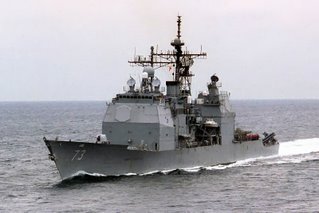
Posted by John Keller
Last spring and summer, an electro-optics company in Westborough, Mass., called RemoteReality Corp. was after me in a big way to talk about a piece of 360-degree optical surveillance technology. It sounded to me like just another perimeter-security application for parking lots and warehouses, so I wasn't in much of a hurry to get the story.
Boy was I wrong, as it turns out, and last Sunday's standoff in the entrance to the Persian Gulf between five Iranian fast attack boats and the U.S. Navy cruiser USS Port Royal, destroyer USS Hopper, and frigate USS Ingraham showed me just why.
Yet early last summer the real importance of the RemoteReality electro-optical system was lost on me. Despite my confusion, James Ionson, RemoteReality's CEO, kept pressing me about the system called OmniAlert360. I asked him straight up if this was just another surveillance camera. He said it definitely wasn't, and that it might involve shipboard surveillance. Because of confidentiality agreements, he couldn't say much more.
The OmniAlert360 has a special kind of mirror that captures a 360-degree field of view, corrects for optical aberrations, and can move the mirror's images to a CMOS sensor for further electronic processing. Sure, it sounded interesting, but why the sense of urgency?
Finally late last July, Ionson could tell me more of the story. RemoteReality was providing the OmniAlert360 to Lockheed Martin to integrate into the Fast Inshore Attack Craft (FIAC) Defense System, which can extend the defensive perimeter of most naval vessels out to five miles to counter the threat of swarms of small attack boats.
This sounded a lot more interesting, and we wrote about it. Still, it wasn't until I saw the news reports Monday morning that I could slap my forehead and sigh, 'well, duh!' Sometimes I can have a mind like a steel trap.
On Sunday five armed Iranian patrol boats that can whoosh over the water at 60 miles an hour (video here) started playing chicken with the three Navy warships in the Strait of Hormuz. Radio traffic from the Iranians reportedly threatened to blow one or more of the ships up. Some of the boats evidently dropped floating boxes into the water ahead of the Navy ships. The task force was within seconds of opening fire on the Iranians before the fast attack boats broke off the engagement.
Subsequently, I read in Wired's Danger Room blog just why the Iranians might have approached the Navy warships, and what it might mean for the future. Sometime soon we might see not just five fast Iranian attack boats but as many as 100 of them at a time engage U.S. warships or cargo vessels from every point of the compass. Right now they're trying to learn our tactics and probe for vulnerable spots.
An attack of 100 fast boats would be extremely hard to defend against ... unless the threatened vessels could detect the attackers from at least five miles out, bring their onboard weapons to bear quickly, and call in air support. That would even the odds. I get it now ... and Jim Ionson, I'm sorry I was so slow on the uptake.
Dear John:
ReplyDeleteThe small boat problem is not new, the US and israel faced with this problem in the 1960s. Back then Egypt sunk an Israli destroyer Eliath (sp?)with one small craft. This was an "over the horizon" OTH missle attack. Part of the solution of that problem was the development of a helo born OTH system mounted in a helocopter and associated sensors and communications deployed on destroyer and cruiser class ships.
Your news is a new sensor added to counter that threat. Kind of interesting we worked the front end of that problem almost 40 years ago and the capability to meet it, to a large degree, has been operational for over 30 years. Also, we have been improving on the cability for the last 30 years.
As an aside, we could have used the capability in Korea in the 1960s when North Korea used small boats to conduct a rain of terror against the South. This terrorism and the vietnam war were linked.